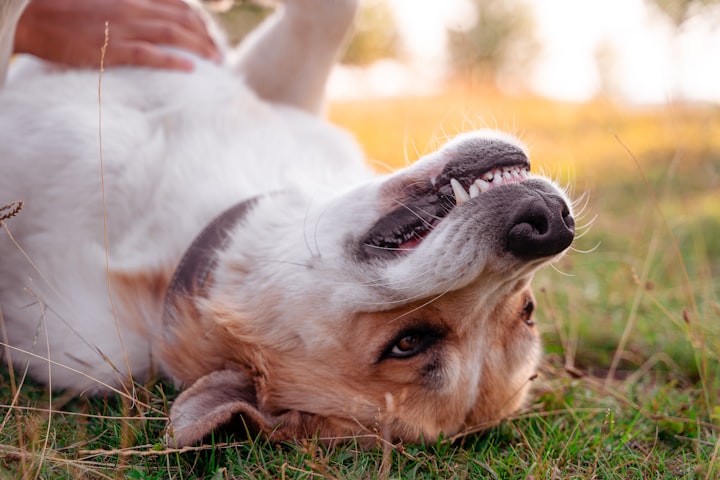The Art of Belly Rubbing
5 Quick Tips to Use Belly Rubbing Help Your Reactive and Fearful Dogs

I bet one of your dog’s favorite interactions with you is getting their belly rubbed.
It’s a submissive and vulnerable behavior for them to ask for some love from you, and it’s also a great opportunity for you to be purposeful while you are giving the belly rubs, and help the dogs to overcome some challenges they might have - such as being uncomfortable while being touched by the vet, or not willing to have their paws to be touched for examining or nail trimming.
When your dog is very relaxed, as they usually are when they are getting the belly rubs from you, it is easier for you to help the dogs push some of their limits without stressing them out as much when they are in a more alert state of mind and/or overstimulated.
What can you do to bring out the art of the belly rubbing, and helping your fearful and reactive dog to be more comfortable with touching and build inner confidence at the same time?
Here're 5 Quick Tips to Help You Get Started:
Firm touch. Like a massage, not a tickle.
When it comes to belly rubs, providing the firm touch and applying even pressures when you rub your pup's belly or other part of the body will offer comfort and help the dog to reach a more relaxed state of mind.
Imagine when you have worked the whole day and stuck in your house due to the pandemic, a deep tissue massage could help you ease your physical pain as well as help you relax your mind and maybe even a better sleep of the night.
Someone gives you a tickle, probably not something you want when you are annoyed and overwhelmed.
Be purposeful. Not just rub the belly.
When I give one of my foster dogs Ketty belly rubs, I often give her some back rubs as well, more so, I touched/held/rubbed all her paws multiple times during the session as well as did a mini mouth/face/ears exam with her. It’s almost like at a relaxed vet visit, I made it as part of her belly rub routine.
The paw touching is also very important and prepares her to be okay to have her paws examined as well as preparing her for the nail trimming, which I was able to do before Ketty found her furever home.
It’s not a play session with your dog, definitely not a teasing game.
Some of the dogs may get playful or mouthy while you are giving them a belly rub, it’s important to know not to engage in those pup games if your goal is to help the dog relax and overcome their fear of certain aspects in their lives.
Besides engaging in the playing will get the dog all excited or even over stimulated as the game could escalate fairly quickly, I’ve seen some dog owners tease the dog using their hands when the dog tries to bite the hands.
Unfortunately, while it could be cute at the moment, the behavior of “trying to bite the hands” is being encouraged, and often leads to unwanted biting behaviors that need to be corrected in the future.
Occasionally, your dog might try to use their paws and body to get closer to you, it’s them being affectionate as well as being playful, you may choose to ignore that behavior and show them they would only get petted if they learn to relax first.
End on a good note, always.
Just like ending on a good note during a training session, you should try to do the same when ending a belly rubbing session.
During the belly rubbing session, massaging certain areas that may make your dog uncomfortable, ensure to get back and massage the area your dog loves to have your dog enjoy the session again before you end the session as we’ve always wanted each session ends on a good note and have your dog enjoy it.
You don’t have to wait till your dog gets bored to end it, simply give a light pet on the shoulder and give a release word/phrase, such as “all done”, then stop the session and walk away or start doing other things.
Your dog may try to beg for more, it’s your choice to give more or not. I’d also suggest not to always give more when the dog is begging rather than giving it randomly (1 out of 3 times or 3 out of 5 times, you get the idea) or ask your dog to offer some behaviors you like first in exchange of belly rubs.
One at a time when you have multiple dogs.
If you have multiple dogs, belly rubbing time could be a great opportunity to establish the respect of space and prevent jealousy and resource guarding as well.
If you have a particularly hard time giving individual attention to one dog when you have other dogs around you, put those dogs away for a little bit while you give one dog the full attention, then put this dog away and bring another dog out.
This is one way to show the dog fairness among all of them. If you start petting the dog being pushy, then you are encouraging the pushy behavior and could cause “jealousy” and resource guarding while you become the resource.
Okay, there are all the goodies I can think of right now, there are some precautions I would consider as well, as dogs are living creatures, and we are not able to know what they are thinking all the time - cookies maybe?
Always accompany your children especially when they are petting or giving belly rubs to the dog.
If your dog fell asleep as they are so relaxed and couldn't keep their eyes open, it’s usually a good time to stop the touching as dogs might get dreamy and get startled by the touch even though your touch didn’t change.
Same concept applies, let’s not interrupt while the dog’s sleeping by suddenly reaching a hand out and start petting them especially if they are in general shy and fearful, being startled they could react pretty badly and possibly hurt you by accident.
Let’s help the dogs relax more thru belly rubs and it’s a “sneaky” way to help your dog build confidence as well.
About the Creator
Grace Henke
Grace Henke is a reactive and fearful dog training expert and the founder of Fair Love Dog Training. She helps dog owners to live a fuller life with a calmer, more relaxed, and well-behaved dog: https://fairlovedogtraining.com/






Comments
There are no comments for this story
Be the first to respond and start the conversation.